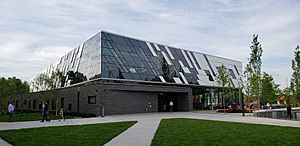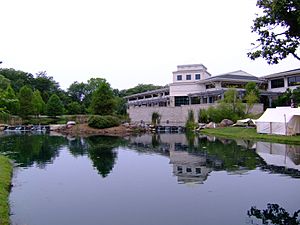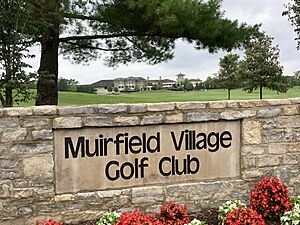Dublin, Ohio facts for kids
Quick facts for kids
Dublin, Ohio
|
|||||
|---|---|---|---|---|---|
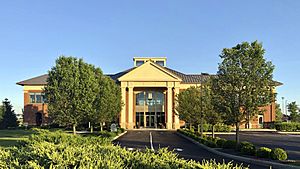
Dublin City Hall
|
|||||
|
|||||
| Motto(s):
"Where Yesterday Meets Tomorrow"
|
|||||
| Country | United States | ||||
| State | Ohio | ||||
| Counties | Franklin, Delaware, Union | ||||
| City status | 1987 | ||||
| Area | |||||
| • Total | 25.04 sq mi (64.85 km2) | ||||
| • Land | 24.68 sq mi (63.92 km2) | ||||
| • Water | 0.36 sq mi (0.93 km2) 1.45% | ||||
| Elevation | 902 ft (275 m) | ||||
| Population
(2020)
|
|||||
| • Total | 49,328 | ||||
| • Estimate
(2023)
|
48,923 | ||||
| • Density | 1,998.62/sq mi (771.67/km2) | ||||
| Time zone | UTC−5 (Eastern) | ||||
| • Summer (DST) | UTC−4 (Eastern) | ||||
| ZIP Codes |
43016–43017
|
||||
| Area code(s) | 614 and 380 | ||||
| FIPS code | 39-22694 | ||||
| GNIS feature ID | 2394565 | ||||
Dublin is a city in the state of Ohio, United States. It's a suburb of Columbus and is located across three different counties: Franklin, Delaware, and Union. In 2020, about 49,328 people lived there. Dublin is known for having the largest three-day Irish festival in the world, called the Dublin Irish Festival. It also has the highest number of people of Asian descent compared to other cities in Ohio.
Contents
Dublin's History
Early Inhabitants
Long ago, Native American groups like the Hopewell, Adena, Delaware, Shawnee, and Wyandot lived in the area that is now Dublin, Ohio.
The Wyandot people moved to Ohio after many of them became sick or were affected by a big war. In 1794, General Anthony Wayne defeated the Wyandot and other Native American groups. This led to the Treaty of Greenville, where the Wyandot gave up most of their land in Ohio.
Chief Shateyaronyah, also known as "Leatherlips", was an important Wyandot leader. He signed the Treaty of Greenville in 1795 and wanted to work with the new settlers. However, this caused problems with two Shawnee brothers, Tecumseh and Tenskwatawa. Tenskwatawa ordered Leatherlips to be killed in 1810 because he wouldn't join the Shawnee. Today, a sculpture in Scioto Park honors Chief Leatherlips.
After the Revolutionary War, the U.S. government gave land to soldiers. Lieutenant James Holt received 2,000 acres along the Scioto River. In 1802, Peter and Benjamin Sells bought 400 acres of this land for their brother, John. This area is now called Historic Dublin.
Becoming a City
In 1808, John Sells and his family moved to the area. By 1810, he started planning the new village with his business partner, John Shields, who was from Ireland. Shields suggested naming the town after his hometown, Dublin, Ireland. He said the beautiful valley reminded him of his birthplace.
By 1833, Dublin had a few mills and a store. It officially became a village in 1881. For a long time, Dublin remained a small town. In 1970, only 681 people lived there. But when Interstate 270 was built, it made the town grow very quickly. Big companies like Ashland Inc and Wendy's International moved their main offices there. Also, the Muirfield Village Golf Club and its neighborhoods attracted many new residents.
Dublin officially became a city in August 1987, after its population reached 5,000. As it grew, Dublin added more land from nearby townships. In 2020, the city started a big project to rebuild the Bridge Street District. This area along the Scioto River will have apartments, shops, and offices. During construction, an African-American cemetery was found. In 2024, a ceremony honored the more than 20 people buried there.
Dublin's Geography
Dublin covers about 24.80 square miles (64.23 km²). Most of this area is land, with a small part being water.
The Scioto River flows through Dublin. In this area, the river has carved deep paths through the rock. The riverbed is stony, and some smaller streams that flow into the Scioto have waterfalls.
Land Features
Dublin is located on a relatively flat area called the Glaciated Allegheny Plateau. However, there are many deep valleys around the streams that feed into the Scioto River. These valleys create steep cliffs in some places. The elevation in Dublin ranges from about 780 feet (238 meters) above sea level near Hayden Run Road to 1,000 feet (305 meters) at Glacier Ridge Metro Park.
Dublin's People
| Historical population | |||
|---|---|---|---|
| Census | Pop. | %± | |
| 1850 | 274 | — | |
| 1880 | 314 | — | |
| 1890 | 296 | −5.7% | |
| 1900 | 275 | −7.1% | |
| 1910 | 239 | −13.1% | |
| 1920 | 211 | −11.7% | |
| 1930 | 224 | 6.2% | |
| 1940 | 237 | 5.8% | |
| 1950 | 289 | 21.9% | |
| 1960 | 552 | 91.0% | |
| 1970 | 681 | 23.4% | |
| 1980 | 3,855 | 466.1% | |
| 1990 | 16,366 | 324.5% | |
| 2000 | 31,392 | 91.8% | |
| 2010 | 41,751 | 33.0% | |
| 2020 | 49,328 | 18.1% | |
| 2023 (est.) | 48,923 | 17.2% | |
| US Census | |||
In 2010, there were 41,751 people living in Dublin. The city had about 15,000 households. Most people (80.5%) were White, and 15.3% were Asian. About 1.8% of the population was Hispanic or Latino.
Among the Asian population in 2010, 6.9% were Indian, 3.1% Chinese, 2.6% Japanese, and 1.3% Korean.
About 45.1% of households had children under 18 living with them. The average age in the city was 38.3 years. About 30.4% of residents were under 18.
Dublin's Economy
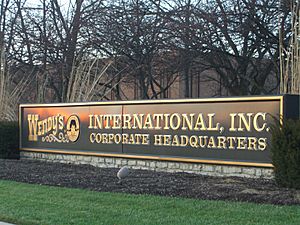
Dublin is home to the main offices of several large companies. One of the biggest is Cardinal Health, which is a very large company in the U.S. Other companies with headquarters in Dublin include IGS Energy, Stanley Steemer, Wendy's, and OCLC. OhioHealth also has a hospital, Dublin Methodist Hospital, in the area.
Top Employers in Dublin
Here are some of the biggest employers in Dublin, based on a 2020 report:
| # | Employer | # of employees |
|---|---|---|
| 1 | Cardinal Health | 4,800 |
| 2 | OhioHealth | 2,000 |
| 3 | Dublin City School District | 1,951 |
| 4 | CareWorks Family of Companies | 1,622 |
| 5 | OCLC | 750 |
| 6 | The Wendy’s Company | 725 |
| 7 | Quantum Health | 600 |
| 8 | Fiserv | 600 |
| 9 | Univar Solutions | 550 |
| 10 | Express Scripts | 500 |
Dublin's Culture
Many of Dublin's parks feature unique outdoor sculptures. These are part of the "Art in Public Places" collection, started by the Dublin Arts Council in 1988. This program helps make the city beautiful and attracts visitors. It has become famous across the country.
Some of the sculptures include:
- A 12-foot (3.7 m) tall stone face of "Leatherlips," the Native American chief.
- Field of Corn, which has 109 human-sized cement ears of corn standing in a field.
- A copper house that honors the Native American history of the area.
At Ballantrae Park, there's a 15-foot (4.6 m) bronze sculpture called Dancing Hares or Giant Dancing Rabbits. There's also a fun water fountain at the bottom of the hill.
The Columbus Metropolitan Library has a branch in Dublin.
Dublin hosts several fun events each year:
- St. Patrick's Day Parade
- The Memorial Tournament (a golf event)
- Independence Day Celebration
- Dublin Irish Festival (the world's largest 3-day Irish festival)
- Halloween Spooktacular
- Veteran's Day Ceremony and Tree Lighting
Japanese Community
Dublin has a notable Japanese community. Many Japanese families moved to Dublin because of Honda operations in nearby Marysville. Dublin offers support for Japanese residents, including Saturday schools for Japanese children. In 2010, 2.6% of Dublin's population was Japanese. By 2013, in some neighborhoods, Japanese residents made up 20–30% of the people living there. The city also has Japanese restaurants. The Dublin City School District provides services for Japanese-speaking students, which attracts many Japanese families to the area.
Parks and Recreation
Dublin has a lot of green space, with about 999.2 acres (4.04 km²) of parks. There are also over 77 miles (124 km) of bike trails and more than 65 developed parks. Many parks are along the Scioto River, where you can access the water for small boats. Nearby reservoirs, Griggs and O'Shaughnessy, allow motorboating and sailing.
The Dublin Community Recreation Center is home to the Dublin Sea Dragons, a swim team that competes all year.
Glacier Ridge Metro Park is just outside Dublin. It offers biking, disc golf, horseback riding, and picnicking. This park is part of the Columbus and Franklin County Metroparks system.
Golf in Dublin
Dublin is famous for its golf courses:
- Muirfield Village Golf Club
- The Country Club at Muirfield Village
- Tartan Fields Golf Club
- The Golf Club of Dublin
Every year since 1976, the Muirfield Village Golf Club hosts the Memorial Tournament, a big event on the golf's PGA Tour. This club has also hosted other major tournaments like the Ryder Cup in 1987 and the President's Cup in 2013. Tartan Fields Golf Club hosted the LPGA's Wendy's Championship for Children from 2002 to 2006.
Transportation
Most people in Dublin get around by car. The main highways are Interstate 270 (also called "the Outerbelt") and State Route 161. U.S. Route 33 also runs through the city, especially through the historic part of Dublin.
The Dublin Link is a special bridge for people walking and biking. It opened in March 2020.
The Central Ohio Transit Authority (COTA) provides bus service in some parts of the city. Route 33 goes to downtown Dublin and the Bridge Street District. Route 73 offers express service to Downtown Columbus during busy times.
For air travel, the closest airport is the Ohio State University Airport, but it's mainly for private planes. For regular commercial flights, people use John Glenn Columbus International Airport near Columbus or Rickenbacker International Airport.
Education in Dublin
Schools for Kids
The Dublin City School District has three high schools: Coffman, Scioto, and Jerome. It also has five middle schools and fifteen elementary schools. In the 2020–2021 school year, about 16,254 students attended schools in the district. A small part of Dublin is also served by the Hilliard City School District.
There are also private schools in the area, like St. Brigid of Kildare Catholic School in Dublin.
The Columbus Japanese Language School, which is a special school for Japanese students, holds classes in Marysville.
Higher Education
Several colleges and universities have branches or campuses in Dublin. These include Ohio University Heritage College of Osteopathic Medicine, Columbus State Community College, Ohio Dominican University, University of Dayton, and Franklin University.
Notable People from Dublin
Many interesting people have connections to Dublin, Ohio:
- Alan Becker, an online animator
- Jeremy Bobb, an actor
- Eric Brunner, a soccer player
- Nate Ebner, an NFL safety and rugby Olympian
- Nick Goings, an NFL fullback
- Sean Kuraly, an NHL hockey player
- Urban Meyer, a famous former football coach for Ohio State University
- Connor Murphy, an NHL hockey player
- Chinedum Ndukwe, an NFL safety
- Jack Nicklaus, a legendary golf champion in the World Golf Hall of Fame
- Brady Quinn, an NFL quarterback
- Chris Quinn, an NBA basketball player
- Jay Richardson, an NFL defensive end
- Mitch Rowland, a Grammy-winning songwriter and guitarist for Harry Styles
- Abby Steiner, a track and field sprinter
- Chad Whitson, an MLB umpire
- Ed Whitson, an MLB pitcher
- Garrett Wilson, an NFL wide receiver for the New York Jets
- Chris Wood, an actor
- Vince Workman, an NFL running back
See also
 In Spanish: Dublin (Ohio) para niños
In Spanish: Dublin (Ohio) para niños










